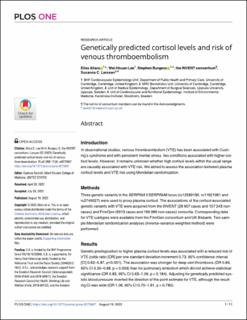| dc.contributor.author | Allarai, Elias | |
| dc.contributor.author | Lee, Wei-Hsuan | |
| dc.contributor.author | Burgess, Stephen | |
| dc.contributor.author | Larsson, Susanna C. | |
| dc.contributor.author | Lindstrom, Sara | |
| dc.contributor.author | Wang, Lu | |
| dc.contributor.author | Smith, Erin N. | |
| dc.contributor.author | Gordon, William | |
| dc.contributor.author | Van Hylckama Vlieg, Astrid | |
| dc.contributor.author | De Andrade, Mariza | |
| dc.contributor.author | Brody, Jennifer A. | |
| dc.contributor.author | Pattee, Jack W. | |
| dc.contributor.author | Haessler, Jeffrey | |
| dc.contributor.author | Brumpton, Ben Michael | |
| dc.contributor.author | Chasman, Daniel I. | |
| dc.contributor.author | Suchon, Pierre | |
| dc.contributor.author | Chen, Ming-Huei | |
| dc.contributor.author | Turman, Constance | |
| dc.contributor.author | Germain, Marine | |
| dc.contributor.author | Wiggins, Kerri L. | |
| dc.contributor.author | Macdonald, James | |
| dc.contributor.author | Brækkan, Sigrid Kufaas | |
| dc.contributor.author | Armasu, Sebastian M. | |
| dc.contributor.author | Pankratz, Nathan | |
| dc.contributor.author | Jackson, Rabecca D. | |
| dc.contributor.author | Nielsen, Jonas B | |
| dc.contributor.author | Giulianini, Franco | |
| dc.contributor.author | Puurunen, Marja K. | |
| dc.contributor.author | Ibrahim, Manal | |
| dc.contributor.author | Heckbert, Susan R. | |
| dc.contributor.author | Bammler, Theo K. | |
| dc.contributor.author | Frazer, Kelly A. | |
| dc.contributor.author | Mccauley, Bryan M. | |
| dc.contributor.author | Taylor, Kent | |
| dc.contributor.author | Pankow, James S. | |
| dc.contributor.author | Reiner, Alexander P. | |
| dc.contributor.author | Gabrielsen, Maiken Elvestad | |
| dc.contributor.author | Deleuze, Jean-Francois | |
| dc.contributor.author | O'Donnell, Chris J. | |
| dc.contributor.author | Kim, Jihye | |
| dc.contributor.author | Mcknight, Barbara | |
| dc.contributor.author | Kraft, Peter | |
| dc.contributor.author | Hansen, John Bjarne | |
| dc.contributor.author | Rosendaal, Frits Richard | |
| dc.contributor.author | Heit, John A. | |
| dc.contributor.author | Psaty, Bruce M. | |
| dc.contributor.author | Tang, Weihong | |
| dc.contributor.author | Kooperberg, Charles | |
| dc.contributor.author | Hveem, Kristian | |
| dc.contributor.author | Ridker, Paul M. | |
| dc.contributor.author | Morange, Pierre-Emmanuel | |
| dc.contributor.author | Johnson, Andrew D. | |
| dc.contributor.author | Kabrhel, Christopher | |
| dc.contributor.author | Alexandretrégouët, David | |
| dc.contributor.author | Smith, Nicholas L. | |
| dc.date.accessioned | 2022-12-20T08:59:53Z | |
| dc.date.available | 2022-12-20T08:59:53Z | |
| dc.date.created | 2022-11-10T10:50:25Z | |
| dc.date.issued | 2022 | |
| dc.identifier.citation | PLOS ONE. 2022, 17 (8), . | en_US |
| dc.identifier.issn | 1932-6203 | |
| dc.identifier.uri | https://hdl.handle.net/11250/3038743 | |
| dc.description.abstract | Introduction
In observational studies, venous thromboembolism (VTE) has been associated with Cushing’s syndrome and with persistent mental stress, two conditions associated with higher cortisol levels. However, it remains unknown whether high cortisol levels within the usual range are causally associated with VTE risk. We aimed to assess the association between plasma cortisol levels and VTE risk using Mendelian randomization.
Methods
Three genetic variants in the SERPINA1/SERPINA6 locus (rs12589136, rs11621961 and rs2749527) were used to proxy plasma cortisol. The associations of the cortisol-associated genetic variants with VTE were acquired from the INVENT (28 907 cases and 157 243 non-cases) and FinnGen (6913 cases and 169 986 non-cases) consortia. Corresponding data for VTE subtypes were available from the FinnGen consortium and UK Biobank. Two-sample Mendelian randomization analyses (inverse-variance weighted method) were performed.
Results
Genetic predisposition to higher plasma cortisol levels was associated with a reduced risk of VTE (odds ratio [OR] per one standard deviation increment 0.73, 95% confidence interval [CI] 0.62–0.87, p<0.001). The association was stronger for deep vein thrombosis (OR 0.69, 95% CI 0.55–0.88, p = 0.003) than for pulmonary embolism which did not achieve statistical significance (OR 0.83, 95% CI 0.63–1.09, p = 0.184). Adjusting for genetically predicted systolic blood pressure inverted the direction of the point estimate for VTE, although the resulting CI was wide (OR 1.06, 95% CI 0.70–1.61, p = 0.780).
Conclusions
This study provides evidence that genetically predicted plasma cortisol levels in the high end of the normal range are associated with a decreased risk of VTE and that this association may be mediated by blood pressure. This study has implications for the planning of observational studies of cortisol and VTE, suggesting that blood pressure traits should be measured and accounted for. | en_US |
| dc.language.iso | eng | en_US |
| dc.publisher | Public Library of Science | en_US |
| dc.rights | Navngivelse 4.0 Internasjonal | * |
| dc.rights.uri | http://creativecommons.org/licenses/by/4.0/deed.no | * |
| dc.title | Genetically predicted cortisol levels and risk of venous thromboembolism | en_US |
| dc.title.alternative | Genetically predicted cortisol levels and risk of venous thromboembolism | en_US |
| dc.type | Peer reviewed | en_US |
| dc.type | Journal article | en_US |
| dc.description.version | publishedVersion | en_US |
| dc.source.pagenumber | 0 | en_US |
| dc.source.volume | 17 | en_US |
| dc.source.journal | PLOS ONE | en_US |
| dc.source.issue | 8 | en_US |
| dc.identifier.doi | 10.1371/journal.pone.0272807 | |
| dc.identifier.cristin | 2071649 | |
| cristin.ispublished | true | |
| cristin.fulltext | original | |
| cristin.qualitycode | 1 | |

